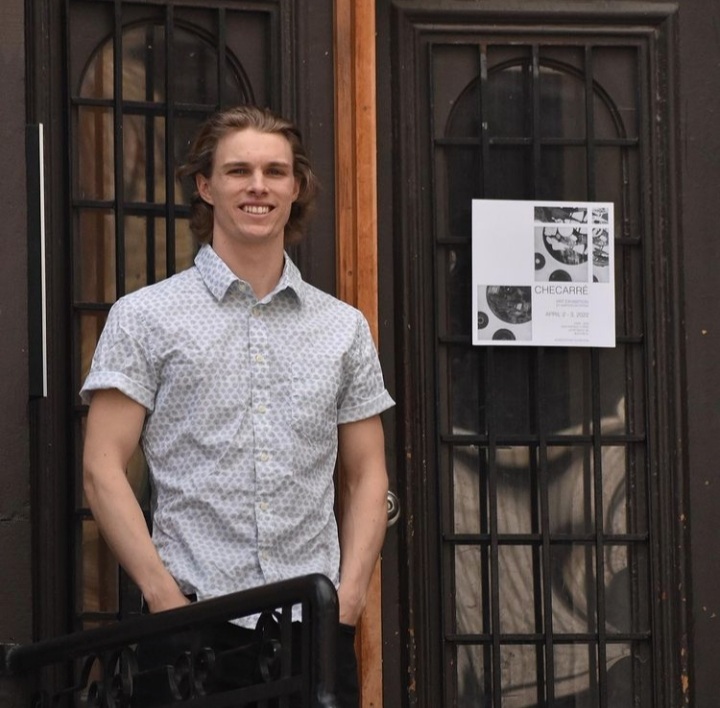“I guess I’m telling my story, the experiences I’ve had, the travels I’ve endured, the places I’ve been and the people I’ve met. Also hearing other stories and bringing people together.”
Sampson McFerrin is a Montreal based artist who is currently studying his third year in Print Media at Concordia University. In April, he held his first art exhibition in which he presented to the public his work, which clearly reflects his journey as an artist.
Checarré is an exhibition that reveals the trajectory of McFerrin as an artist throughout the years. He has covered over 50,000 kilometers in nearly 30 countries. He claims that this unique experience has not only influenced his art but has also shaped him into the person he is today.
“Before I was born, my parents travelled around the world for two years, and when they had me they wanted to keep that lifestyle. I was introduced to it from a really young age and it was just how it was. Now I’ve taken it as a passion of my own, it made me the person who I am.”
Being a mixed word and at the same time denoting the creativity of the artist, Checarré signals different meanings and tonalities.The first part of this word means “checking-in” since McFerrin is in his third year and has a desire to give criticism a place in his work. The second part, carré, comes from the French and literally translates to “square” since he claims that for some reason, his works continue to end up in squares, something that has worked for him. The third and last part of this word––originally suggested by his brother––also comes from the French; the expression chez moi, denoting the reason behind McFerrin’s decision to hold his exhibition in his own apartment. This makes the spectator’s experience feel much warmer and closer to the message of the works.
How unique it is to be able to encounter the mixture of one’s oldest and latest works as is the case with Checarré. McFerrin explained that he has been painting since grade four and has been more serious about it since grade ten when he started selling his work. However, for five years, he feels that in his latest work he only notices very small differences. That’s one of the reasons why he decided to switch to print media:”I was ageing for something more or just some new technical skills to learn.”
Artists have often reflected on the role failure has played into their career’s evolution. Nonetheless, it is very difficult to define the role that failure has had when this term is so subjective. Having spent much of his life painting, McFerrin has become a very open-minded person. Proof of this mindset can be observed through the response he gave to The Concordian when asked about the role of failure in his own artistic process: “I don’t think failure has ever been an option.”
Learning from mistakes, falls and success is just part of the learning process, as the artist explained “Even if I fail, it is okay. It is what you learn from that and what you have to do to make sure you pass to the next one. Failure has never been an option, make it work! If you’re biking and the bike breaks down you’ll get a tiny moment of ‘oh no!’ But then it all is about what’s next. There is always something to do. If something does not go as you wanted, make it work in the best way for you.” That is McFerrin’s message.
His flexible mentality is noticeable in his art in which he also draws the image of his passion for bicycles––Rain Pants Party is his favourite work, an acrylic-based painting. A very personal work and even an “extension of self” as he commented.
Through Checarré, he presents his most unique side, a life experience that results in a narrative of his experiences which have not only transformed him as a person but have led him to create meaningful connections with people who can see themselves represented in his work.
Through a refreshing conversation with the artist, one can not only get an insight into his career in the world of painting and printmaking, but also an admirable glimpse into a unique lifestyle that has helped him keep an open mind, a fundamental skill for life.
After observing Checarré, it is very easy to realize that, as the artist himself said, art is everywhere. This project can precisely serve as an inspiration for youth who are doubting the veracity of the path to art so that they take the leap. “Do what makes you happy, switch to what makes you happy, don’t give up on that,” McFerrin encourages. Through his work, McFerrin sees his most recent and older work living together and admits to still learning how to use print media, which he denotes through his art the importance of patience in the art world.
Visuals courtesy Sampson McFerrin
